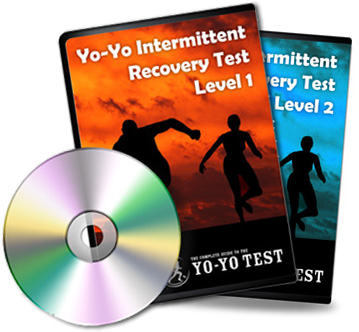Yo-Yo Test History
Traditionally, the assessment of team sport athletes involved an aerobic fitness test such as the 12-minute run or more recently the Leger "beep" shuttle run test. However, questions about the relevance of these tests to intermittent sports led to the development of the yo-yo series of tests.
The tests were first proposed by the soccer physiologist Jens Bangsbo in the 1990. The yo-yo intermittent and recovery tests are based on the more aerobic endurance 'beep' test, with the addition of an active recovery period of 5 or 10 seconds after each 40m rum, and with faster running speeds so that there is greater stress on the anaerobic energy system. The name yo-yo is obvious, with the participants required to runs like a yo-yo back and forth between markers at a given speed.
Bangsbo first presented the yo-yo tests in 1994 (Bangsbo, 1994). With his colleagues, Bangsbo investigated the validity and reliability of the tests, publishing the results in 2003 (Krustrup et al., 2003). Since then, the tests have quickly become a common test of the ability to repeatedly perform high-intensity exercise for team sports players, and are the subject of hundreds of research papers (see selected references).
As Bangsbo has worked predominantly with the sport of football (soccer), the yo-yo test was initially popular in that sport, and gradually come in favour for testing other sports which are similarly intermittent in nature, and its use is now is not limited to just intermittent type sports.
Some Significant Milestones
1994 - Bangsbo first published information about the yo-yo tests (Bangsbo, 1994)
2003 - first scientific research paper published (Krustrup et al., 2003)
2005 - a cd version of the test was first published, available to purchase on Bangsbosport.com
The SPARQ Testing protocols for soccer included the yo-yo test.
2017 - Australian football included the 20m shuttle run test in their national combine testing protocols until 2017 when they replaced it with the yo-yo IR1
2017 - The Yo-Yo test was first introduced into the Indian Cricket Team by the strength and conditioning Coach Shankar Basu in 2017, and it is now a requirement of national players to reach a certain level in the test before they can be selected, and also for many players in the IPL.
2018 - Singapore's domestic professional football league replaced the player mandatory testing of the 2.4 km run with the Yo-Yo Intermittent Recovery test in 2018. The Yo-Yo test will be conducted three times a year – pre-season, mid-season and at the end of the season.
References
- Krustrup P, Mohr M, Amstrup T, Rysgaard T, Johansen J, Steensberg A, Pedersen PK, Bangsbo J. (2003). The yo-yo intermittent recovery test: physiological response, reliability, and validity. Med Sci Sports Exerc, 35(4), 697-705. doi: 10.1249/01.MSS.0000058441.94520.32
- Jens Bangsbo, F. Marcello Iaia and Peter Krustrup, (2008) The Yo-Yo Intermittent Recovery Test: A Useful Tool for Evaluation of Physical Performance in Intermittent Sports, Sports Medicine; 38 (1): 37-51.
- Bangsbo J. (1994) Fitness Training in Football: A Scientific Approach. Bagsværd, Denmark: HO Storm, 1–336.
More Resources
- More information about Jens Bangsbo, the original creator of the yo-yo tests.
- List of information pages
- Buying the Yo-Yo Test
Cite this Page


